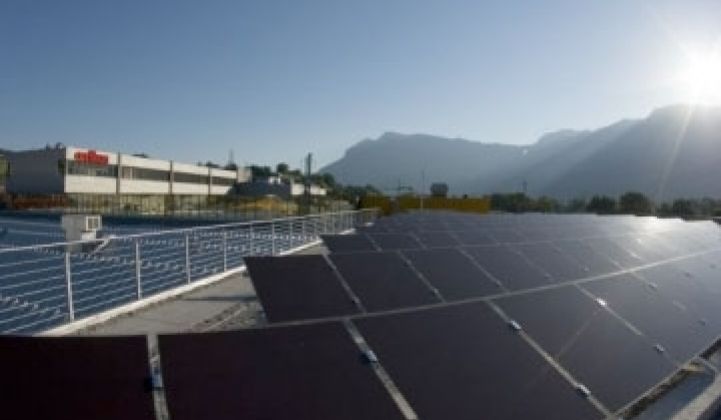Even as there's a bit of turmoil in the Applied Materials SunFab amorphous silicon group, Oerlikon, a company also building a turn-key factory for solar, might be seeing strong results both technologically and commercially.
I spoke with Oerlikon Solar's head of market development and government relations for North America, Chris O'Brien. He claimed that Oerlikon has been using the slow period in the market as an opportunity to drive down cost in its product. He believes that the firm is on a path to drive down the cost of production to $.70 per watt with their "micromorph" dual layer product. (Mike Miskovsky of Canadian Solar referred to the recent down market as "Solar in the time of cholera" TM.)
In O'Brien's words, "By the end of the year we’ll be offering our customers a manufacturing plant design that will put them in a position to compete with First Solar, the industry’s cost leader." O'Brien's not a newcomer to the field. He's worked at utility AES, Sharp Solar and was also the chairman of SEIA (Solar Energy Industries Association).
So, how is Oerlikon doing better with this product than semiconductor and materials master Applied Materials?
According to O'Brien, Oerlikon has been down the cost-reduction road in other industries and their engineers are not intimidated by aggressive cost reduction targets. O'Brien cited cost reduction through constant improvements in productivity at each manufacturing step with less material and faster throughput. They're looking to reduce capex and opex, and to accelerate evolution in their PECVD tool.
In addition, Oerlikon has pioneered the commercial introduction of comparatively higher efficiency tandem-junction thin film silicon with up to 50 percent higher efficiency than single junction amorphous.
But Applied has to be running that race, as well. Applied is no slouch in the Moore's Law cost-reduction contest. Indeed, they've been the driver of Moore's Law for decades in the semiconductor space.
In O'Brien's words, "The race is to see if we're competitive with the crystalline suppliers." According to O'Brien, Oerlikon manufacturing lines are operating in China (2), Taiwan (2), Germany (4), Spain, and Switzerland. None are yet in operation in the U.S.
Meanwhile, Applied Material's customers are declaring bankruptcy (Sunfilm) and backing out of factories (Signet).
So what is Oerlikon doing differently?
Oerlikon might have a bit of an advantage in efficiency due to a technology choice in transparent conductive oxide (TCO). Oerlikon Solar uses a Zinc Oxide (ZnO) TCO applied with a LPCVD process that is optimized for increasing light capture and is integrated into Oerlikon's turnkey lines. Applied is still using a PVD-based Tin Oxide (SnO) TCO.
From a business standpoint, Oerlikon's O'Brien sees the big challenge right now as a "volatility in the price forecast for crystalline and thin-film modules, making it more challenging for new thin film manufacturers to get financing." He also sees that "Business has been steered to Asia because of lack of U.S. capital, although he notes that there is strong interest in Ontario with a large domestic requirement and an aggressive Feed-in-Tariff." And adds, "We're hopeful for several projects in the U.S. that will be finished but still are awaiting completion of financing, including ARRA funding."
O’Brien notes that there is growing support for legislation later in 2010 that will extend and expand the ARRA provisions for U.S. solar manufacturing, which will help potential Oerlikon customers seeking to develop new tandem thin-film manufacturing plants in the U.S.
Other firms like Sharp, Anwell Technologies and NexPower are already producing or entering mass production of a-Si panels.
Achieving low module cost-per-watt and low capex cost-per-watt is difficult with any solar technology and perhaps even more so with low efficiency a-Si. Competing against Applied Materials is also a challenge -- no one should underestimate the capabilities of that firm. But Applied is not the real competition here. Instead, it's First Solar and a score of low-cost c-Si companies. And Oerlikon is going to have to overachieve at execution and R&D to keep up with those pacesetters.
In the view of GTM Research Solar Analyst, Shyam Mehta, "Amorphous silicon’s long-term future lies in the commercialization and adoption of tandem-junction technology. First movers in this space (Sharp, Oerlikon customers) have a distinct advantage." (See Mehta's recent report, Thin Film 2010, Market Outlook to 2015.) Mehta adds, "When it comes to single- and tandem-junction technologies, Oerlikon emerges as the clear efficiency leader in the field: four of the top six single-junction and five of the top seven tandem-junction firms use its manufacturing equipment."
But Mehta cautions, "Oerlikon suggests that its current costs are around $1 per watt, and that a further 30% reduction would be achieved by the end of this year. However, it is difficult to believe that any Oerlikon customer has actually achieved a cost of $1 per watt in practice, given the small plant sizes and expected low capacity utilizations evident through 2009. Therefore, when it comes to actual production costs, the 70-cent-per-watt target may be somewhat optimistic, especially given the lead-time required for construction and ramp-up."



